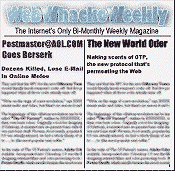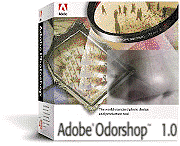
Making scents of
OTP,
the new protocol that's
permeating the Web
They said that the RFC for the new Olfactory Transmission Protocol (OTP) would literally knock everyone's socks off. But few people were prepared for what happened when all those socks actually came off.
"We're on the verge of a new revolution," says multimedia guru Nicholas Nasalponte. "Multimedia originally meant audio and video, but there's no reason it can't cover five senses... or more!"
The beginnings of this olfactory revolution can be traced back to a shareware product called "The Ol' Factory", written by Sean O'Dour, which allowed users to construct their own basic odors. Originally a tool for designing Open Look interfaces (OLfactory), it mutated into its present form with the advent of OTP. "At first, it was just basic stuff. Flowers, food smells, popular fragrances. By the time Version 0.0 was actually released, we had a whole library of smells, ranging from rose petals, to chicken soup, to coffee, and back again."
 In the wake of The
Ol' Factory's success, Adobe Odorshop was soon made available.
Incorporated into Odorshop 1.0 was the GLADE Plug-In
API, for
designing external filters and odor processing tools. Metatools soon released
Kai's Power
Smells
which rapidly became the most popular set of olfactory add-ons for
Odorshop. KPS Air Freshener and KPS Fragrance Designer incorporated a number of useful filters and functions that are now considered essential in the digital perfumery business.
In the wake of The
Ol' Factory's success, Adobe Odorshop was soon made available.
Incorporated into Odorshop 1.0 was the GLADE Plug-In
API, for
designing external filters and odor processing tools. Metatools soon released
Kai's Power
Smells
which rapidly became the most popular set of olfactory add-ons for
Odorshop. KPS Air Freshener and KPS Fragrance Designer incorporated a number of useful filters and functions that are now considered essential in the digital perfumery business.
 But what good are
all these tools for odomanipulation and odoretouching if you can't
interface your odors to the outside world? "If an odor travels
through the net, and no one's there to smell it, does it make a
stink?" asks Steve Jobs of Apple, who is spearheading the
effort to make next generation Macintoshes support the new odor
technology.
"We will be providing native support for OTP
and other odor-related protocols in the next version of the MacOS,"
Jobs announced at a recent Apple developer conference.
"We will also be including smell ports on all new Macintoshes for
direct olfactory input and output."
But what good are
all these tools for odomanipulation and odoretouching if you can't
interface your odors to the outside world? "If an odor travels
through the net, and no one's there to smell it, does it make a
stink?" asks Steve Jobs of Apple, who is spearheading the
effort to make next generation Macintoshes support the new odor
technology.
"We will be providing native support for OTP
and other odor-related protocols in the next version of the MacOS,"
Jobs announced at a recent Apple developer conference.
"We will also be including smell ports on all new Macintoshes for
direct olfactory input and output."
Apple will not be utilizing the well-established SCSI bus architecture that people have been using to attach devices like scanners to their systems. Instead, they will be exploiting the newly-developed Software Managed Logical Interface (SMLI) technology to hook up the new "sniffers" directly to these next generation Macintoshes.
